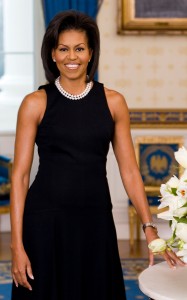Photo of the first first lady Martha Washington, left, and photo of current first lady Michelle Obama, right. (Photos are in the public domain.)
For those who wonder what exactly the role of the first lady is, you are not alone. First ladies wonder about that too.
“It was a demanding job, but it comes with no job description,” former first lady Betty Ford once said.
Anita McBride, who served as chief of staff for former first lady Laura Bush from 2005-2009, said that “every first lady wrestles with” the role they are expected to play.
“(The role) is defined by the first lady herself,” McBride said.
McBride spoke to students at George Mason University, Purdue University and the University of Denver April 14 during a live video conference from Washington, D.C. Steve Scully, senior executive producer and political editor of C-SPAN , hosted the video conference which is part of a C-SPAN and University of Denver distance learning course.
Although there is no job description for the first lady, there were certain traditional expectations of the role that emerged early on. McBride said a first lady was expected to:
- Act as a social hostess
- Be caretaker of the White House
- Be a traditional homemaker
But, McBride said those expectations have evolved.
“Over time we have come to expect so much more out of first ladies,” McBride said, “we really do expect our first ladies to be deeply engaged in issues that they care about and issues that the nation cares about.”
She said the first modern first lady was defined by Eleanor Roosevelt.
“(She) was very active on a number of issues and continued, until she died, as a human rights activist,” McBride said.
First ladies have the flexibility to pick and choose issues they want to focus on, she said, but they can be strategic in choosing their causes.
“First ladies are best when they choose…to work on policy issues that are of importance to the administration at large,” McBride said. “You don’t want to be running a shadow government; you don’t want to be running your own White House.”
First ladies also help to carry out their husband’s vision, McBride said. Hillary Rodham Clinton’s fight for healthcare was an example.
“It’s a great risk, of course, to be putting yourself out there on a public issue,” McBride said.
She said Clinton’s move was “very risky, but important.”
“She did sort of redefined, a little bit, how engaged a first lady could be on a particular issue of such tremendous importance and significance in the country,” McBride said.
The role of the first lady, and a future first spouse, includes working collaboratively with the President on issues that are important to the nation, McBride said. And although questions of what a first lady does still arise, McBride said a first lady works 24-7.
“It is probably the most important and most demanding unpaid job in the world,” she said.
The video conference with McBride can be viewed at http://www.c-span.org/Distance_Learning/. Other video conferences from the distance learning course are also available. The course, which is done in collaboration with The Cable Center, will not be offered again at the University of Denver after the 2011 Spring Semester.





